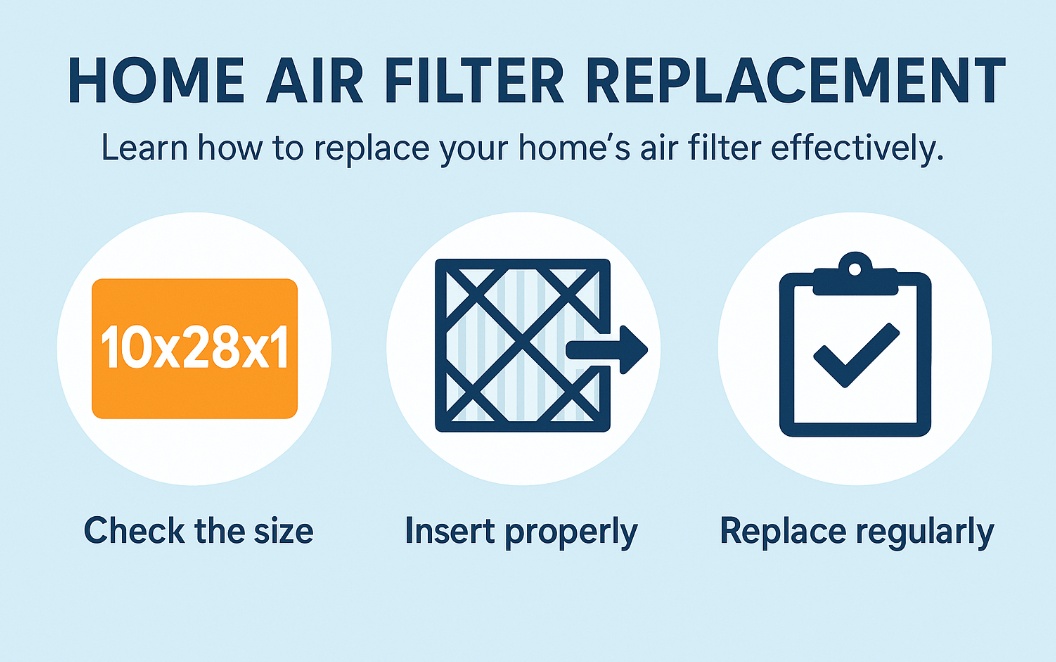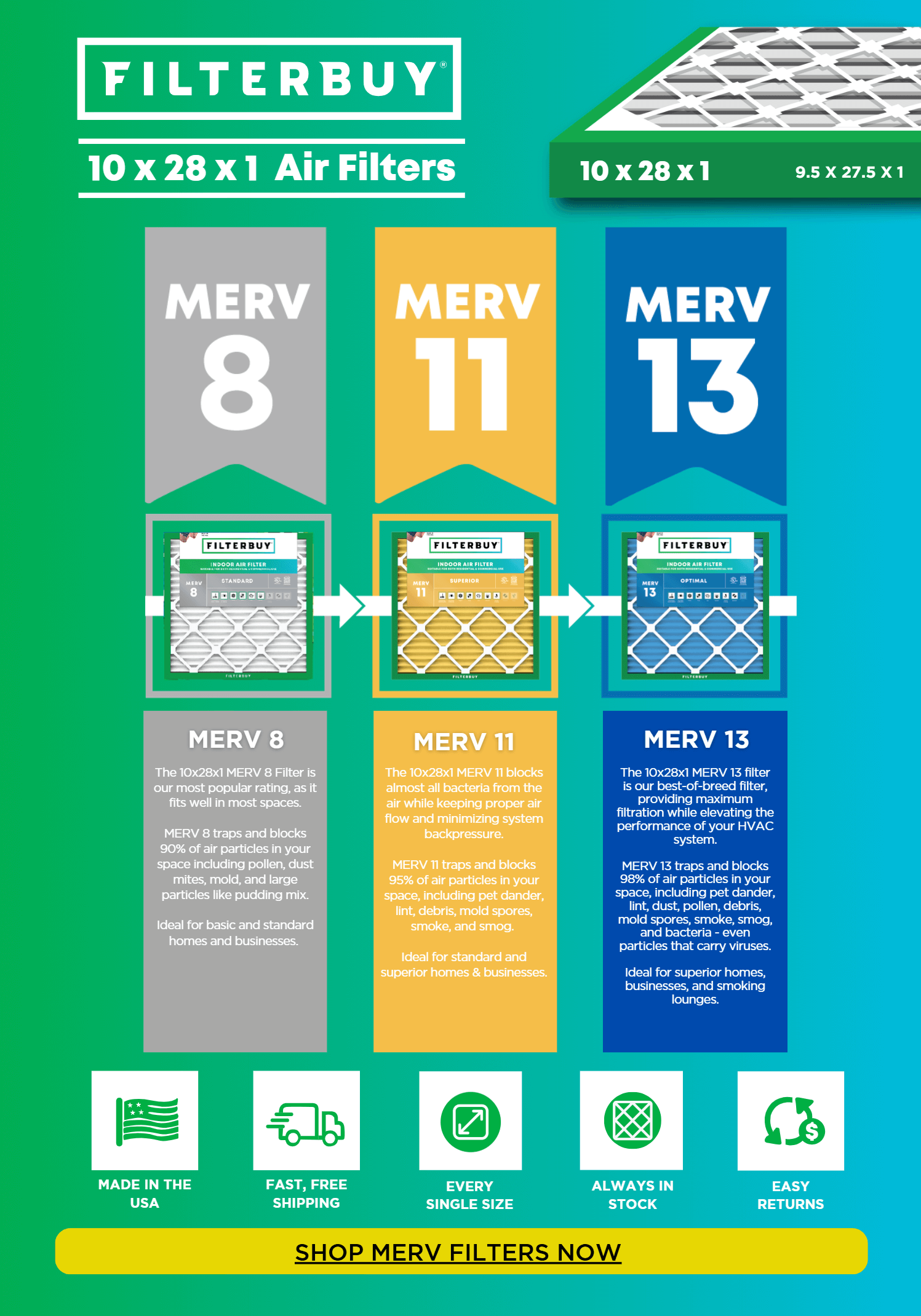10x28x1 HVAC Filter Replacement How-To for Homeowners
Quick Answers
10x28x1 Air Filters
A 10x28x1 air filter helps maintain clean air and steady airflow in your home. Replace it every 60–90 days (more often with pets or allergies), choose a MERV rating that fits your air quality needs, and make sure the size matches exactly—most airflow issues we see begin with the wrong or overdue filter.
Top Takeaways
- Correct size is essential. The right 10x28x1 filter keeps airflow steady and protects your HVAC system.
- Replace every 60–90 days. Prevents dust buildup, high energy use, and avoidable service calls.
- Choose the right MERV rating. Balances air quality, airflow, and system efficiency.
- Many issues start with the filter. Airflow and comfort problems often improve immediately with the correct filter.
Good filtration gives control. Cleaner air and more consistent HVAC performance come from regular maintenance.
A 10x28x1 filter is designed to capture dust, pollen, pet dander, and other airborne particles before they circulate through your home. When replaced on schedule, it supports better indoor air quality and helps your HVAC system run with less strain.
What homeowners should know:
- Confirm the size: Always match the exact 10x28x1 dimensions printed on your existing filter’s frame or your system’s manual. Even slight variations can reduce efficiency.
- Check replacement frequency: Most homes benefit from a new filter every 60–90 days, but we’ve found that families with pets or allergies often need more frequent changes.
- Look for airflow direction: Use the arrows on the frame to ensure correct installation. A reversed filter can restrict airflow and increase system wear.
- Assess filter performance: If rooms feel dusty or your system runs longer than usual, the filter is often the first problem to address.
By choosing the right 10x28x1 filter and replacing it regularly, homeowners can extend equipment life, maintain healthier indoor air, and avoid preventable service calls. This quick guide gives you the essential steps to make confident, informed decisions that keep your home’s HVAC system running at its best.

“After years of visiting homes with airflow problems, I’ve learned that most issues start with one overlooked detail—the wrong or overdue air filter. A properly fitted 10x28x1 filter doesn’t just clean your air; it protects your entire HVAC system. When homeowners get this step right, everything else runs smoother.”
Essential, Trusted Resources Every Homeowner Should Use When Researching 10x28x1 Air Filters
1. EPA Indoor Air Quality Guide – Get Clear on What Your Filter Needs to Defend Against
2. EPA Residential Air Cleaners Summary – See How Filtration Actually Works in Real Homes
3. Energy Star HVAC Efficiency Tips – Learn How Filter Changes Save Energy and Money
4. CDC Indoor Environmental Quality – Protect Your Home From Hidden Air Issues
5. ASHRAE Filtration Standards – Decode MERV Ratings With Confidence
6. ACCA Homeowner HVAC Care – Know How Pros Maintain System Airflow
7. U.S. Department of Energy Heating & Cooling Guide – Maximize HVAC Performance With Proper Filter Use
Supporting Statistics
- Indoor air is 2–5× more polluted than outdoor air.
- We see this often in homes with overdue filters.
- EPA confirms indoor pollutants accumulate quickly.
- Dirty filters can raise HVAC energy use by up to 15%.
- Field visits show systems working harder when filters clog.
- 25 million Americans have asthma.
- Better filtration reduces irritants that trigger symptoms.
- AAFA highlights the prevalence of asthma nationwide.
Source: https://aafa.org/asthma/prevalence/
Final Thought & Opinion
Replacing a 10x28x1 air filter is a small task with big benefits. The steps above cover sizing, installation, and why regular changes matter.
What we see most often
- Many homeowners underestimate how much a neglected filter affects comfort and airflow.
- Wrong or overdue filters cause dust buildup, higher energy bills, and unnecessary strain.
Why this matters
- A well-fitted filter helps your HVAC work efficiently.
- Routine changes prevent avoidable service calls.
My take after years of field experience
- The air filter is the first place I check when diagnosing airflow issues.
- Most problems improve immediately once the right filter is installed.
- A properly maintained 10x28x1 filter gives homeowners more control and fewer surprises.
In short, a simple, well-chosen filter delivers fast comfort, better air, and a healthier HVAC system.
Next Steps
- Verify your filter size.
- Confirm the 10x28x1 dimensions on your current filter or HVAC manual.
- Check the filter’s condition.
- Replace if it’s dirty, dark, or older than 60–90 days.
- Select the right MERV rating.
- Match your home’s needs (allergies, pets, airflow).
- When unsure, follow system guidelines or ASHRAE recommendations.
- Install it correctly.
- Follow airflow arrows.
- Ensure a snug, sealed fit.
- Set a replacement reminder.
- Every 60–90 days, or more often with pets/allergies.
- Monitor performance.
- Watch for dust, longer run times, or uneven temps.
- Review trusted resources.
Continue improving air quality and HVAC efficiency.
FAQ on 10x28x1 Air Filters
Q: What does a 10x28x1 filter do? A:
- Captures dust, pollen, and pet debris.
- Helps maintain steady airflow.
- Often improves comfort immediately when replaced on time.
Q: How often should I replace it? A:
- Every 60–90 days for most homes.
- More often with pets, allergies, or high dust levels.
Q: How do I confirm it fits my system? A:
- Check the size printed on your current filter.
- Exact dimensions matter—“close enough” can cause airflow problems.
Q: Which MERV rating should I choose? A:
- Lower MERV = better airflow.
- Mid–high MERV works well for allergy-prone homes.
Q: What if I install the filter backward? A:
- Airflow is restricted.
- The system works harder and less efficiently.
Learn more about HVAC Care from one of our HVAC solutions branches…
Filterbuy HVAC Solutions - Miami FL - Air Conditioning Service
1300 S Miami Ave Apt 4806 Miami FL 33130
(305) 306-5027
https://maps.app.goo.gl/Ci1vrL596LhvXKU79

